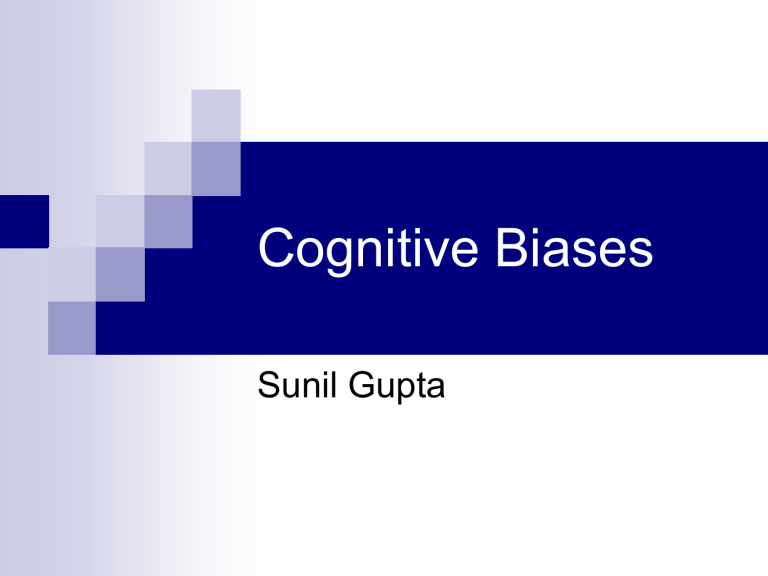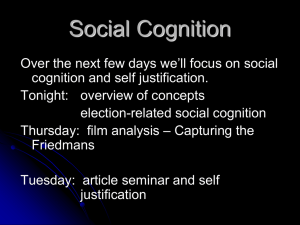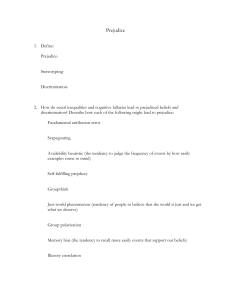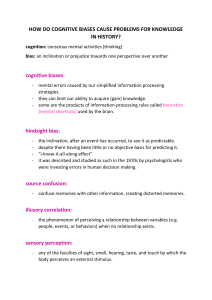
Cognitive Biases Sunil Gupta Cognitive Bias A cognitive bias is a pattern of poor judgment, often triggered by a particular situation. The existence of most of the particular cognitive biases listed has been verified in psychology experiments. Why they exist Cognitive biases are influenced by evolution and natural selection pressure. Some are presumably adaptive and beneficial, for example, because they lead to more effective actions in given contexts or enable faster decisions, when faster decisions are of greater value for reproductive success and survival. Others presumably result from a general fault in human brain structure or the misapplication of a mechanism that is beneficial under different circumstances. Some areas where Cognitive biases occur Decision-making and behavioural biases. Biases in probability and belief. Social biases. Memory errors and biases Decision-making and behavioural biases Many of these biases are studied for how they affect belief formation, business decisions, and scientific research. Anchoring – the common human tendency to rely too heavily, or "anchor," on one trait or piece of information when making decisions. Attentional Bias - implicit cognitive bias defined as the tendency of emotionally dominant stimuli in one's environment to preferentially draw and hold attention. Decision-making and behavioural biases Backfire effect - Evidence disconfirming our beliefs only strengthens them. Bandwagon effect - the tendency to do (or believe) things because many other people do (or believe) the same. Related to groupthink and herd behaviour. Bias blind spot – the tendency to see oneself as less biased than other people. Choice-supportive bias - the tendency to remember one's choices as better than they actually were. Decision-making and behavioural biases Confirmation bias - the tendency to search for or interpret information in a way that confirms one's preconceptions. Congruence bias - the tendency to test hypotheses exclusively through direct testing, in contrast to tests of possible alternative hypotheses. Contrast effect - the enhancement or diminishing of a weight or other measurement when compared with a recently observed contrasting object. Denomination effect - the tendency to spend more money when it is denominated in small amounts (e.g. coins) rather than large amounts (e.g. notes). Decision-making and behavioural biases Distinction bias - the tendency to view two options as more dissimilar when evaluating them simultaneously than when evaluating them separately. Empathy gap - the tendency to underestimate the influence or strength of feelings, in either oneself or others. Endowment effect - the fact that people often demand much more to give up an object than they would be willing to pay to acquire it. Decision-making and behavioural biases Experimenter’s or Expectation bias - the tendency for experimenters to believe, certify, and publish data that agree with their expectations for the outcome of an experiment, and to disbelieve, discard, or downgrade the corresponding weightings for data that appear to conflict with those expectations. Focusing effect - the tendency to place too much importance on one aspect of an event; causes error in accurately predicting the utility of a future outcome. Framing effect - drawing different conclusions from the same information, depending on how that information is presented. Decision-making and behavioural biases Hostile media effect - the tendency to see a media report as being biased due to one's own strong partisan views. Hyperbolic discounting - the tendency for people to have a stronger preference for more immediate payoffs relative to later payoffs, where the tendency increases the closer to the present both payoffs are. Illusion of control - the tendency to overestimate one's degree of influence over other external events. Impact bias - the tendency to overestimate the length or the intensity of the impact of future feeling states. Decision-making and behavioural biases Information bias - the tendency to seek information even when it cannot affect action. Irrational escalation – the phenomenon where people justify increased investment in a decision, based on the cumulative prior investment, despite new evidence suggesting that the decision was probably wrong. Loss aversion - the disutility of giving up an object is greater than the utility associated with acquiring it, (see also Sunk costs effects and Endowment effect). Mere exposure effect - the tendency to express undue liking for things merely because of familiarity with them. Decision-making and behavioural biases Money illusion - the tendency to concentrate on the nominal (face value) of money rather than its value in terms of purchasing power. Moral credential effect - the tendency of a track record of non-prejudice to increase subsequent prejudice. Negativity bias - the tendency to pay more attention and give more weight to negative than positive experiences or other kinds of information. Neglect of probability - the tendency to completely disregard probability when making a decision under uncertainty. Decision-making and behavioural biases Normalcy bias – the refusal to plan for, or react to, a disaster which has never happened before. Omission bias - the tendency to judge harmful actions as worse, or less moral, than equally harmful omissions (inactions). Outcome bias - the tendency to judge a decision by its eventual outcome instead of based on the quality of the decision at the time it was made. Planning fallacy - the tendency to underestimate task-completion times. Decision-making and behavioural biases Post-purchase rationalisation - the tendency to persuade oneself through rational argument that a purchase was a good value. Pseudocertainty effect - the tendency to make riskaverse choices if the expected outcome is positive, but make risk-seeking choices to avoid negative outcomes. Reactance - the urge to do the opposite of what someone wants you to do out of a need to resist a perceived attempt to constrain your freedom of choice. Restraint bias - the tendency to overestimate one's ability to show restraint in the face of temptation. Decision-making and behavioural biases Selective perception - the tendency for expectations to affect perception. Semmelweis reflex - the tendency to reject new evidence that contradicts a paradigm. Social comparison bias - the tendency, when making hiring decisions, to favour potential candidates who don't compete with one's own particular strengths. Decision-making and behavioural biases Status quo bias - the tendency to like things to stay relatively the same (see also loss aversion, endowment effect and system justification). Unit bias - the tendency to want to finish a given unit of a task or an item. Strong effects on the consumption of food in particular. Wishful thinking - the formation of beliefs and the making of decisions according to what is pleasing to imagine instead of by appeal to evidence or rationality. Zero-risk bias - preference for reducing a small risk to zero over a greater reduction in a larger risk. Biases in probability and belief Many of these biases are often studied for how they affect business and economic decisions and how they affect experimental research. Ambiguity effect - the tendency to avoid options for which missing information makes the probability seem "unknown." Anchoring effect – the tendency to rely too heavily, or "anchor," on a past reference or on one trait or piece of information when making decisions (also called "insufficient adjustment"). Biases in probability and belief Attentional bias – the tendency to neglect relevant data when making judgments of a correlation or association. Availability heuristic – estimating what is more likely by what is more available in memory, which is biased toward vivid, unusual, or emotionally charged examples. Availability cascade – a self-reinforcing process in which a collective belief gains more and more plausibility through its increasing repetition in public discourse (or "repeat something long enough and it will become true"). Base rate neglect or Base rate fallacy – the tendency to base judgments on specifics, ignoring general statistical information. Biases in probability and belief Belief bias – an effect where someone's evaluation of the logical strength of an argument is biased by the believability of the conclusion. Clustering illusion – the tendency to see patterns where actually none exist. Also referred to as "patternicity“. Conjunction fallacy – the tendency to assume that specific conditions are more probable than general ones. Forward Bias - the tendency to create models based on past data which are validated only against that past data. Biases in probability and belief Frequency illusion - the illusion in which a word, a name or other thing that has recently come to one's attention suddenly appears "everywhere" with improbable frequency (see also recency illusion). Sometimes called "The Baader-Meinhof phenomenon". Gambler’s fallacy - the tendency to think that future probabilities are altered by past events, when in reality they are unchanged. Results from an erroneous conceptualization of the Law of large numbers e.g. "I've flipped heads with this coin five times consecutively, so the chance of tails coming out on the sixth flip is much greater than heads." Biases in probability and belief Hindsight bias - sometimes called the "I-knew-it-allalong" effect, the tendency to see past events as being predictable at the time those events happened. (sometimes phrased as "Hindsight is 20/20"). Illusory correlation - inaccurately perceiving a relationship between two events, either because of prejudice or selective processing of information. Just-world hypothesis – the tendency for people to want to believe that the world is fundamentally just, causing them to rationalize an otherwise inexplicable injustice as deserved by the victim(s). Biases in probability and belief Observer-expectancy effect - when a researcher expects a given result and therefore unconsciously manipulates an experiment or misinterprets data in order to find it (see also subject-expectancy effect). Optimism bias – the tendency to be over-optimistic about the outcome of planned actions. Ostrich effect – ignoring an obvious (negative) situation. Overconfident effect – excessive confidence in one's own answers to questions. For example, for certain types of questions, answers that people rate as "99% certain" turn out to be wrong 40% of the time. Biases in probability and belief Positive outcome bias – the tendency of one to overestimate the probability of a favourable outcome coming to pass in a given situation (see also wishful thinking, optimism bias and valence effect). Pareidolia – a vague and random stimulus (often an image or sound) is perceived as significant, e.g., seeing images of animals or faces in clouds, the man in the moon, and hearing hidden messages on records played in reverse. Pessimism bias – the tendency for some people, especially those suffering from depression, to overestimate the likelihood of negative things happening to them. Primacy effect – the greater ease of recall of initial items in a sequence compared to items in the middle of the sequence. Biases in probability and belief Recency effect – the greater ease of recall of items at the end of a sequence compared to items earlier in the sequence. Recency bias – a cognitive bias that results from disproportionate salience of recent stimuli or observations — the tendency to weigh recent events more than earlier events (see also peak-end rule). Recency illusion - the illusion that a phenomenon, typically a word or language usage, that one has just begun to notice is a recent innovation (see also frequency illusion). Disregard of regression toward the mean - the tendency to expect extreme performance to continue. Biases in probability and belief Stereotyping - expecting a member of a group to have certain characteristics without having actual information about that individual. Subadditivity effect – the tendency to judge probability of the whole to be less than the probabilities of the parts. Subjective validation – perception that something is true if a subject's belief demands it to be true. Also assigns perceived connections between coincidences. Well travelled road effect - underestimation of the duration taken to traverse oft-travelled routes and overestimate the duration taken to traverse less familiar routes. Social biases Most of these biases are labelled as attributional biases - the way we determine who or what was responsible for an event or action (attribution). Actor-observer bias – the tendency for explanations of other individuals' behaviours to overemphasize the influence of their personality and underemphasize the influence of their situation (see also Fundamental attribution error), and for explanations of one's own behaviours to do the opposite (that is, to overemphasize the influence of our situation and underemphasize the influence of our own personality). Social biases Dunning-Kruger effect - a twofold bias. On one hand the lack of metacognitive ability deludes people, who overrate their capabilities. On the other hand, skilled people underrate their abilities, as they assume the others have a similar understanding. Egocentric bias - occurs when people claim more responsibility for themselves for the results of a joint action than an outside observer would. Forer effect (aka Barnum effect) – the tendency to give high accuracy ratings to descriptions of their personality that supposedly are tailored specifically for them, but are in fact vague and general enough to apply to a wide range of people. For example, horoscopes. Social biases False consensus effect - the tendency for people to overestimate the degree to which others agree with them. Fundamental attribution error – the tendency for people to over-emphasize personality-based explanations for behaviours observed in others while under-emphasizing the role and power of situational influences on the same behaviour (see also actorobserver bias, group attribution error, positivity effect and negativity effect). Halo effect - the tendency for a person's positive or negative traits to "spill over" from one area of their personality to another in others' perceptions of them (see also physical attractiveness stereotype). Social biases Illusion of asymmetric insight - people perceive their knowledge of their peers to surpass their peers' knowledge of them. Illusion of transparency - people overestimate others' ability to know them, and they also overestimate their ability to know others. Illusory superiority - overestimating one's desirable qualities, and underestimating undesirable qualities, relative to other people. (Also known as "Lake Wobegon effect," "better-than-average effect," or "superiority bias"). Ingroup bias – the tendency for people to give preferential treatment to others they perceive to be members of their own groups. Social biases Just-world phenomenon - the tendency for people to believe that the world is just and therefore people "get what they deserve." Moral luck - the tendency for people to ascribe greater or lesser moral standing based on the outcome of an event rather than the intention Outgroup homogeneity bias - individuals see members of their own group as being relatively more varied than members of other groups. Projection bias - the tendency to unconsciously assume that others (or one's future selves) share one's current emotional states, thoughts and values. Social biases Self-serving bias – the tendency to claim more responsibility for successes than failures. It may also manifest itself as a tendency for people to evaluate ambiguous information in a way beneficial to their interests (see also group-serving bias). System justification - the tendency to defend and bolster the status quo. Existing social, economic, and political arrangements tend to be preferred, and alternatives disparaged sometimes even at the expense of individual and collective self-interest. (See also status quo bias.) Trait ascription bias - the tendency for people to view themselves as relatively variable in terms of personality, behaviour, and mood while viewing others as much more predictable. Ultimate attribution error - similar to the fundamental attribution error, in this error a person is likely to make an internal attribution to an entire group instead of the individuals within the group. Memory errors and biases Cryptomnesia - a form of misattribution where a memory is mistaken for imagination. Egocentric bias - recalling the past in a selfserving manner, e.g., remembering one's exam grades as being better than they were, or remembering a caught fish as being bigger than it was. False memory - a form of misattribution where imagination is mistaken for a memory. Hindsight bias – filtering memory of past events through present knowledge, so that those events look more predictable than they actually were; also known as the "I-knew-it-all-along effect." Memory errors and biases Positivity effect - older adults remember relatively more positive than negative things, compared with younger adults. Reminiscence bump - the effect that people tend to recall more personal events from adolescence and early adulthood than from other lifetime periods. Rosy retrospection - the tendency to rate past events more positively than they had actually rated them when the event occurred. Self-serving bias - perceiving oneself responsible for desirable outcomes but not responsible for undesirable ones. Memory errors and biases Suggestibility - a form of misattribution where ideas suggested by a questioner are mistaken for memory. Telescoping effect - the effect that recent events appear to have occurred more remotely and remote events appear to have occurred more recently. Von Restorff effect – the tendency for an item that "stands out like a sore thumb" to be more likely to be remembered than other items. Further reading Wikipedia http://en.wikipedia.org/wiki/List_of_cognitive_biase s Irrationality by Stuart Sutherland, Published by Pinter & Martin Ltd; ISBN-10: 1905177070 Mistakes Were Made (but Not by Me): Why We Justify Foolish Beliefs, Bad Decisions and Hurtful Acts by Carol Tavris, Publisher: Pinter & Martin Ltd. ISBN-10: 1905177216




